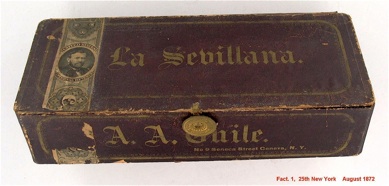Cardboard Cigar Boxes
A National Cigar Museum Exclusive
© Tony Hyman

Cardboard Cigar Boxes
A National Cigar Museum Exclusive
© Tony Hyman
Machine made cardboard appeared in the early 1850’s. Although expensive items had been packaged in and-made cardboard previously, mechanization meant increased production and uniformity, making it practical for box makers to handle. They could now offer large numbers of custom made and printed products to brokers and factories. Cigars, hats and shoes were early products packed in cardboard. Their various containers were similar, different mostly in size and type and placement of labels. Box design changed over the years, but cardboard remained in the game, constantly adapting.
This exhibit is intended as a testimonial to all the folks who made, designed and used cardboard packaging for cigars. Their inventiveness amazes me.
Ten pack
Attractive gold and black slide “cdb 10/5 slide box” made shortly after boxes of 10 regular size cigars became legal in 1910. The small red on blue revenue stamp stands out and was short lived (1910-1918), making it easy to identify the earliest boxes of five and ten cigars. Orange on blue are the most common stamps (1918-1942) so don’t get the colors confused.
[3540]
Eight pack
Packages of 8 are every bit as rare as packs of 7. Among puzzles of US tax laws is why large cigars could be packed in 7’s but not 8’s and small cigars could be packed in 8’s but not in boxes of 7. Why? Because some-one wanted it that way and was a successful lobbyist.
“All tobacco cigarette” is a euphemism for small cigar first uttered in the 1880’s and still going strong in 1938. Overprints are common on seldom used stamp sizes.
Trade publications frequently carry ads from cigar companies spotlighting their new methods of pack-aging to wholesalers and other readers. This style of display for “cdb 5 packs” was an immediate hit.
In 1950 H.Fendrich became the second US cigar factory to celebrate a 100th anniversary.
[3826]
To see an exhibit of H.Fendrich’s history, click <here>.
20th Century 5 packs
Lightweight cardboard containers similar to this held small boxes of 5 or 10 cigars. Actors, dancers, singers and other performers and their roles have been featured on cigar boxes since the 1840’s (and possibly before). Movie actors and characters were on boxes before the industry was twenty years old so no surprise to see one of the screen’s greatest romantic idols on a 1920’s box.
[3561]
The movie actor most often seen on a box is Douglas Fairbanks, who was already on a box as a stage actor before he come to Hollywood, made a hit, and got a redesigned label emphasizing his film career. The earlier version is quite rare.
To see an exhibit of actors & actresses, click <here>
The only thing special about an otherwise typical monochromatic cardboard push pack is the fact it held 7 cigars. I’ve seen five boxes of 500 in a lifetime of collection, but this is the only 7. Springer (the revenue stamp collector’s bible) shows the 7 as appearing in 1926 as an OP on a 1918, but doesn’t list a 7 in 1918, adding the confusion over its origin. This box dates from 1955, and is probably the only package of cigars you’ll see with that pricing.
[3554]
A one piece inexpensive monochromatic cardboard five pack with a die cut window has graphics reminiscent of the 1930’s or 40’s but was actually created and used in the 1970’s.
Is FORE really a good brand name for a box of FIVE cigars?
“Gimme fore cigars” does not flow trippingly on the tongue when you really want five.
To see more poor choices of brand names and images click <here>.
In contrast to the MARKSMAN this type of 5 pack was made of one flat die cut printing, glued along one edge. By the 1960’s this type packaging was among the most popular ways of retailing cigars. The red on blue tax stamp gives away this colorful cardboard 5 pack’s 1910-1917 origins at a glance.
[3570]
A popular brand since the 1870’s, MARKSMAN used this attractive “cdb 5/5 pull pack” in the early 1920’s. During the 1880’s the brand was distinctive in a square packed “NW 100/10” displaying the full outer label. The same company made POET as their 10¢ brand.
[3549]
Slim Eastern Ohio stogies were still packed in clean cardboard cans in the 1920’s, their 70th year of use for that purpose. There are no absolutes, but stogie cans tended to be monochrome, two color at most, to cut costs. This can is red, the two previous are red & blue and red & brown.
Cardboard cans date back to the 1850’s, more than a half century before the first recorded round tin can. Cardboard cans and shoe boxes were commonly used for stogies, though regular cigars were packed in them as well. This colorful 1947 “cardboard 50/up sliptop” housed a brand made in Florida as a custom brand celebrating a NH trail’s lookout for someone in New England. Printing technology made colorful can labels more affordable by mid century.
[3532]
Wheeling WV stogie makers used large numbers of cardboard cans in the 1800’s, one reason so few 19th century stogie boxes are found today. c1910
[2010]
Eight-sided cardboard can “cdb 50/up octagon”used by a KY stogie manufacturer around 1912. Octagonal “uprights” are known in tin, wood, and glass as well but are most rare in cardboard.
[2009]
Larger cardboard boxes
The goal of this section is to showcase some of the many creative ways in which cardboard has been used to package cigars in 20, 25, 50 and 100 boxes.
OUR POET (Longfellow) exemplifies more complex 19th Century cardboard packing, here a simulated trunk (now missing its leather handle) with an inside collar much like a wooden boite nature box. Attractive full color inner cut down to fit. 1890’s.
[4299]
[3716]
This style cardboard 10//5 box was intro-duced in the 1880’s, almost immediately replacing bundles as the preferred form of cigarette packaging. Less than 2” wide and less than 3” tall, it was a two parter, an exterior printed four sided sleeve and a plain cardboard inside which “slid” in and out when given a “push” from the bottom. Whether you call it a ‘slide pack’ or a ‘push pack’ these tiny 10/5 were still being used for Little Cigars in the 1950’s.
This is the style of package in which baseball cards and other inserts could be found during the Golden Age (Centennial to World War One). This JACK ROSE is unopened, but unlikely to have inserts other than advertising or coupon since it dates after 1920.
H.Ellis of Baltimore was a major maker of small cigars and cigarettes, bought up by the Tobacco Trust in their effort to corner the market. This 2¾” pack is from 1909.
This 1956 RECRUIT is still packaged in the traditional “10/5 pushpack,” but now made by cigarette giant Liggett & Myers, one of the companies re-formed after the break-up of the Trust in 1911. Note the design change reflecting declining rele-vance of the Civil War among smokers.
Catalog page from one of the largest Pittsburgh stogie makers, R.W. Jenkinson, depicting use of cardboard shoeboxes and cans. In 1910, this type of packaging had been used for 60 years. The box would be described as a “cdb 100/10 shoebox.” The fact the end is not square indicates the cigars had been mould, press or packing box flattened before packing, probably a gimmick to make DUDE STOGIES distinctive. Pittsburgh, c1910. A tour of Jenkinson’s factory is elsewhere in the National Cigar Museum.
[2049]
Slide push pack of 5 cigars patented in 1882 is made in two parts, an outer sleeve and an internal insert, pushed or pulled (note the tab and instructions) to expose the cigars. Since 5 packs were not yet legal, Straiton & Storm would have packed these in a larger legal size box of 100, 200, 250 or 500. The large container was probably a cardboard counter display. None are known to have survived.
Front of the pack. VEGUEROS were a thin 4” long and promoted as what vegueros (Cuban tobacco growers) smoked. Romantic, but absurd. Straiton & Storm is one of history’s largest, oldest and more important cigar makers, eventually becoming General Cigar.
[3551] [3550]
Patent issued in 1865 for cardboard disposable box containing 5 cigars and matches. Packages of five cigars wouldn’t become legal until 1910 but they could be packed inside larger legal size boxes to which stamps could be attached.
[5195]
Shoebox style cardboard box used by Royal Douglass of Cambridgeport, MA, for cigars in the 1850’s. Many people mistakenly believe cardboard boxes weren’t used until modern days. During the 80 years between the US Civil War (early 1860’s) and WWII (early 1940’s), cheroot and stogie makers frequently utilized similar shoe box style packaging. Not many survived because they weren’t sturdy. Shoe boxes used top labels similar to those found in the earliest days of Cuban boxes, and rarely had inside labels.
[3526]
Earliest cardboard cigar containers
Remarkable round cardboard box made in Cuba in the 1850’s. Has bilingual (Spanish & French) instructions for opening the package (like when the first flat top beer cans explained how to use an opener). The bottom of the box is hand sewn on with waxed thread, as is the flat top to the sides of the top. The top is imprinted with a signed note from “The captain general” in the name of the King confirming their Cuban authenticity,
Byron’s image has appeared on boxes for 150 years because he was an early 1820’s poetic apologist for cigars. This is the earliest reported Byron box.
[3524]
A bilingual (Spanish & French) note explains that the new individual size cardboard containers will prevent cigars from breaking and keep them fresh on their sea voyage from Cuba. This box is the earliest upright cigar box yet found as well as the earliest appearance of a government guarantee.
[3525]
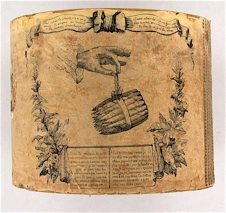

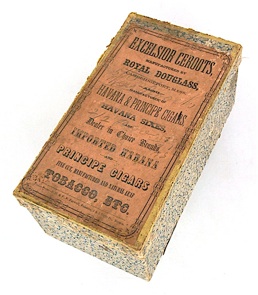
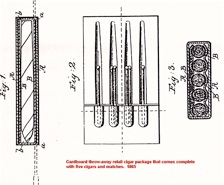


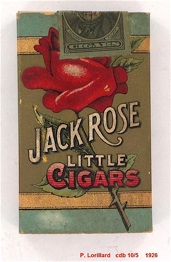
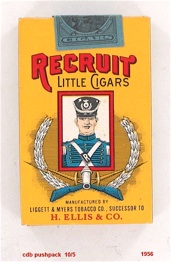
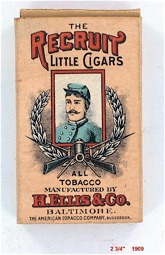
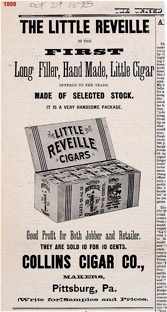
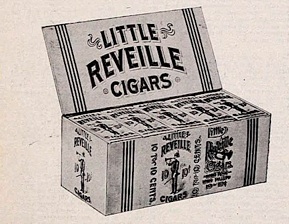

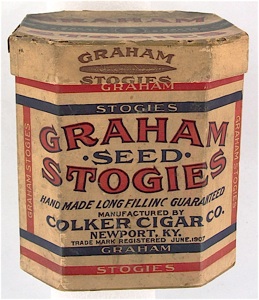
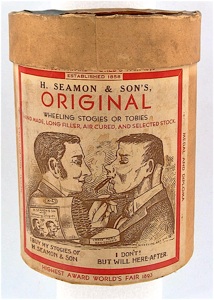
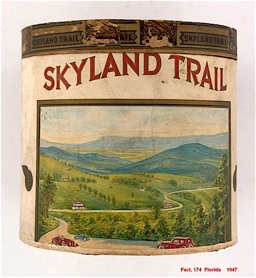
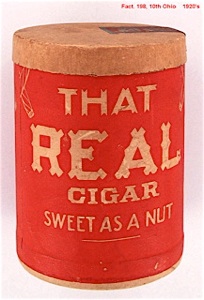
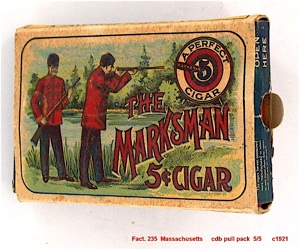
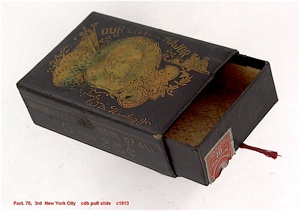
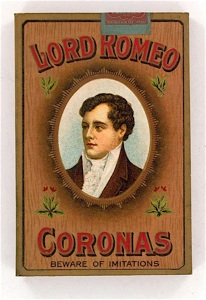
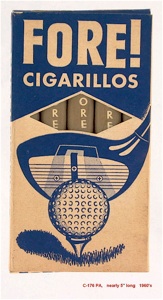
Cardboard Cans
Holding cigars made in Davenport, IA, in 1924, this “cdb 10/5 lift top” is about the simplest package possible. Only three parts: a plain white box right out of a box maker’s stock catalog, an inexpensive cut-down outer label and the obligatory legal notices on the bottom. Most likely a short run, or a way of clearing out left-over labels or cigar inventory. ¿Quien sabe?
[3539]
A fast-moving 20th century world of automobiles and telephones and movies and radio demands a quick smoke less than 3½” long. Ever-rising sales of cigarettes forced the cigar industry to pay increasing attention to small cigars after 1910.
[3536]
Paper hinged “cdb 10/5” was a standard box, especially popular with makers of “Little Cigars.” VAN BIBBER was a widely available nationally advertised Tobacco Trust brand passed on to Lorillard in 1911. The use of foil was actually fairly common in boxes large and small. What appears to be early lead foil has been found in NW 50 and 100 boxes as far back as the 1870’s.
[3537]

Made in NYC by F. Regensburg in 1929, this “cdb hinged 10/5” has a custom label both inside and out, typical of a major high-production brand of an important maker. In the Cuban tradition, the original maker’s name (Fernandez) appears on the box many years after he died and the brand name was sold.
[3616]
The inside label on this “cdb 10/5” is a miniature version of that used on their 50/13 packaging. The lid was originally hinged with ordinary paper rather than the cloth hinges used on wooden boxes, a cost-design decision that made sense as the hinge could be integrated into the labeling and had only to be strong enough to last 10 openings and closings. Collectors find them today with torn hinges (as here) more often than not.
[3615]


Founded in 1880, F.M. Howell was an important supplier of inexpensive labels nationwide, but especially to thousands of nearby NY and PA factories (1880-1930). After WWII they created many distinctive small cardboard boxes and cartons. The Howell family still ran the business 125 years later, the oldest surviving US printer-box maker.

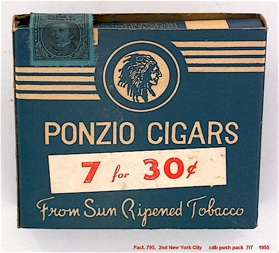

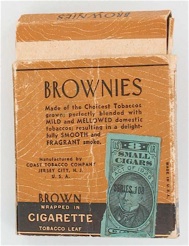
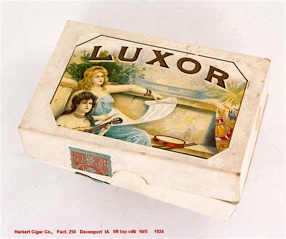

Small “cdb 10/5” packs gained in popularity to the point where they dominated sales by the 1960’s. A widely sold flavored cigar was offered in 2 different box styles, but using the same artwork. The upright box seen it its three flavors of artwork was the more popular of the two with smokers. 1960’s
Elaborate and attractive cardboard packaging. Sealed packages of 5 small cigars inside larger decorated hinged and labeled boxes of 100 inside a large shoe box type box with a dropfront. The inside label on the long boxes is the same as that on the dropfront. Good design and execution. Possibly more expensive than the cigars warranted. Or they were 10¢ worth of cigars sold for 25¢ and a lot of packaging. Perhaps unique. Made in one of the giant NYC factories. c1914.
The Italian cigar industry of California and New York is a collecting and research hobby of its own. Many colorful types of cardboard boxes were used for these short dry crudely shaped fire funnels. This large lightweight cardboard sliptop box held small tax-paid five packs. All four side ads are printed upside down because the slip top lid was intended to be removed and slipped under the interior box, now becoming a four-sided ad. Rossi Cigar Co., Oakland, CA, 1951
[3562]
Thanks to a 1955 magazine coupon and a buck, New York mail order company, Wally Frank, sent this 16 year old collector a free (full) sample box that’s about as plain as you can get. This “cdb 25/13” slip top box with no hinge, no label, just a simple red logo and ad copy. Elaborate packaging wasn’t warranted for cigars that were mailed free. And yes, I did smoke the cigars to my regret then and now.
[4320]
Another very plain mail order cigar box, this hinged “cdb 50/13” box has an inner label and paper hinge. This simulated wood box was used by Tampa mail order company Swann in the early 1950’s.
[4312]
Cigars made in KY for St. Louis wholesaler F.R. Rice Mercantile Co., user of innovative packages. This attractive Christmas cardboard 25/13 box made in 1927 exemplifies good design possible using only two colors. The tradition of colorful Christmas boxes goes back to the 1870’s.
[4126]
To see more Christmas boxes click <here>.
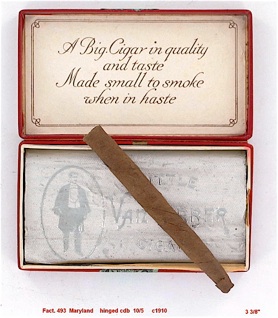
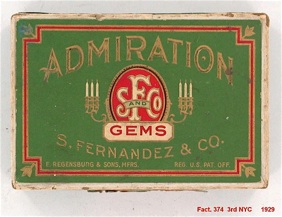
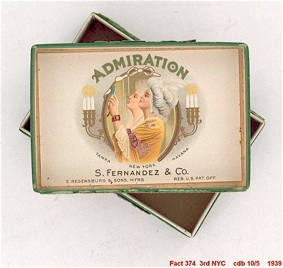
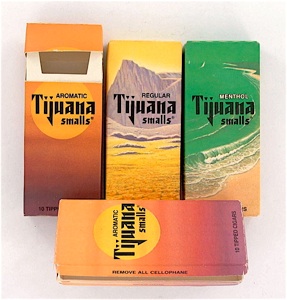
Pennsylvania’s prominent Yocum Bros used this unusual flocked cardboard 20/10. They advertised it as a “personal package.” Note placement of revenue stamp to keep the top design clean. Reading, PA, 1930
[4319]

This complicated piece of 1930’s cardboard construction housed 50 WEBSTER cigars, another leading brand. Here an interior open box is wrapped with a one piece fold-around, glued on the ends with an added strip of paper, and button clasped. Novel, but impractical, expensive and short lived.
[4322]
In 1931, Yocum Bros., makers of national best-seller Y-B, offered their 5¢ SPANA-CUBA in an unusually complicated cardboard box within a box that used a metal support to pull up the inside box into an angled position to better display the cigars. Clever, but how cost effective?
[4311]
Alligator skin embossed cardboard in green and maroon. The lid supports were a reaction to complaints that the paper hinges on cardboard boxes couldn’t hold the lid erect to display the brand name. Notice the notch to accommodate the lid’s grommet pivot hinge.
HARVESTER had been popular for 30 years in 1948 when the company attempted to attract
attention to the cigars by displaying them on a slant. Slanting the box made it stand out, and was especially useful when shopkeepers tore the lids off boxes. [6533]
You’ve seen other companies try expensive contraptions and hinges to slant their box in a display counter. The approach of this box was more simple and added only one step in the box making process, an all-the-way-through die stamping. Clever, but few retailers found it convenient and the makers of HARVESTER decided the cost-benefit ratio wasn’t significant to continue ordering the extra die.
[6532]
Makers of DUTCH MASTERS have long been known for their innovative packaging, and this attempt to solve the slant problem is ingenious. Note how a stiff cardboard “pry bar” shoves the inner box upward as the top lid is raised into position. Another nice feature of the design is that the inner box acts like the collar of a BN providing somewhat of an air-seal. Exact date this box was offered is unknown: 1970’s [?]
[4323]
Certainly one of the more attractive cardboard boxes of any decade is this GOLD LABEL Swagger from 1968. Very common.
[4316]
At first glance an ordinary box, but far from it. The manufacturing process was all new, folding the box from a single sheet of printed and die cut lightweight cardboard, fastening the corners with a full height type of metal staple. The lid tucks in, rather than resting on the front of the box. [3528]
When opened, the die cut lid is folded and tucked in the back, turning the top brand into the inner label. Similar folding was used 50 years previously (see RUDOLPH VALENTINO) but a good idea is a good idea. This differs from the earlier attempt in the double folding of the sides and the use of metal staple hinges. The box held 50 cellophaned cigars. Very clever!
[3527]
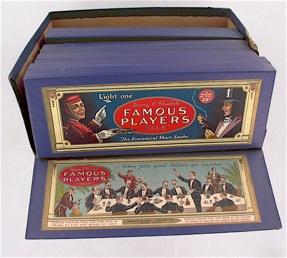
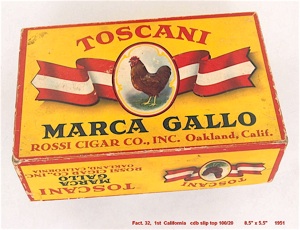
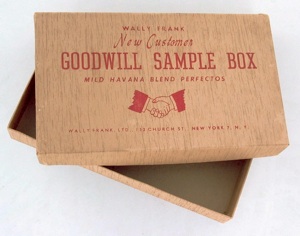
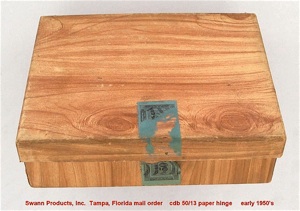
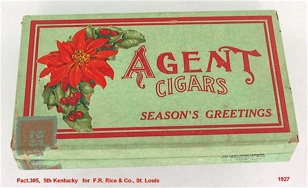
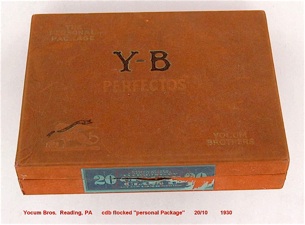

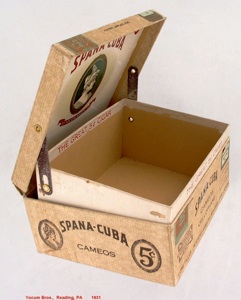
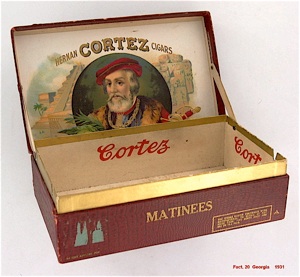
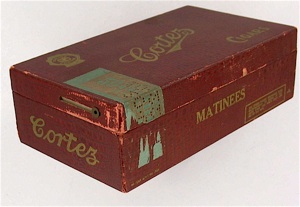

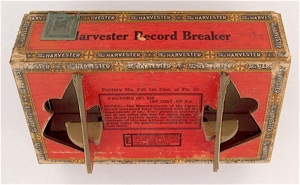
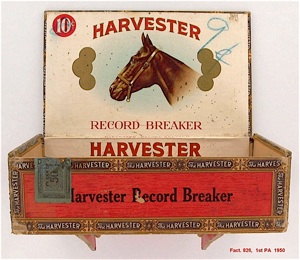
Cigarillo box
Although the technique had been around for a decade, the first type of cigar box to regularly use “box wrapped” cardboard was the small
50/13 designed for cigarette-size cigarillos. The diminutive 4” x 5” x 2” size was ideal for the industry to perfect the new box manufacturing techniques involving integrating edging, front mark, end label and bottom printed government notices into one sheet of paper and wrapping it around the box. The inner label and ‘top sheet’ remained separate as did the paper hinge. Experiments to make the hinge part of the top sheet were tried.
ROBT. BURNS and KING EDWARD appear to have been the first large users, but dozens of companies offered cigarillo size cigars packed in “box wrapped” boxes in the 1950’s.
The Maxfield Parrish label makes this 1942 box particularly desirable to collectors. [2420]
To see more Cigarillo boxes, click <here>.
Wrapped standard 50/13 cardboard
Making cigar boxes by fully automated machine involved an all new approach to labeling and edging called “box wrap.” Only three pieces of paper were involved: [1] the bottom, four sides, end label, legal requirements, front mark and edging were all printed on one piece of paper which was “wrapped” around the blank cardboard box, [2] the “top sheet” containing the top brand and edging, and [3] the inside label. The white box required no liner. These three pieces were applied in one second or less in contrast to minutes of hand labor required to trim a box the old way. 1942

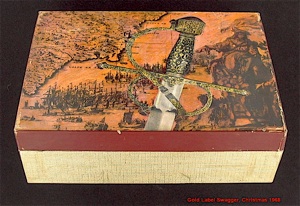

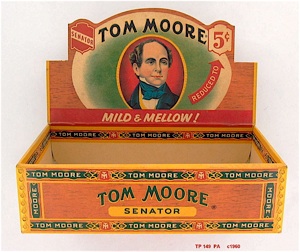
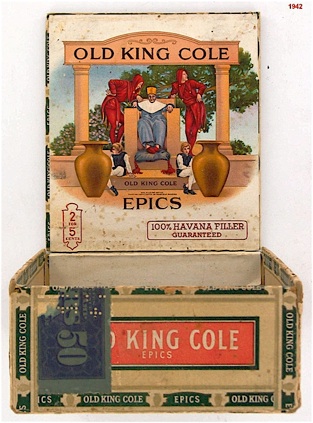
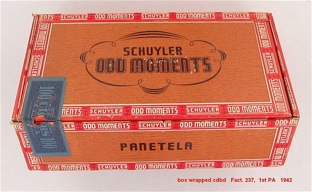
Very rare 1872 cardboard box with unique inset beveled lid, string and button clasp, and heavy cloth hinge.
Box is a 100/20 used by A.A. Guile of Geneva, NY (Fact. 1, 25th Dist. NY).
The brand is a knock-off of a famous early Cuban brand of that name (see the NCM exhibit of early Cuban labels). [3348]

